warning light FIAT TALENTO 2018 Owner handbook (in English)
[x] Cancel search | Manufacturer: FIAT, Model Year: 2018, Model line: TALENTO, Model: FIAT TALENTO 2018Pages: 232, PDF Size: 5.54 MB
Page 86 of 232
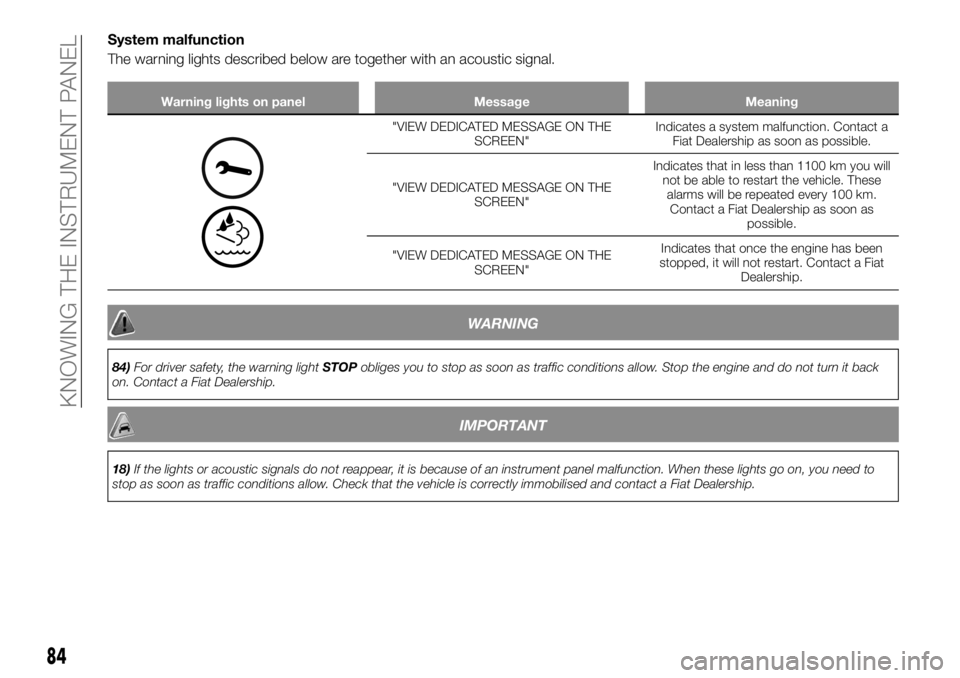
System malfunction
The warning lights described below are together with an acoustic signal.
Warning lights on panel Message Meaning
"VIEW DEDICATED MESSAGE ON THE
SCREEN"Indicates a system malfunction. Contact a
Fiat Dealership as soon as possible.
"VIEW DEDICATED MESSAGE ON THE
SCREEN"Indicates that in less than 1100 km you will
not be able to restart the vehicle. These
alarms will be repeated every 100 km.
Contact a Fiat Dealership as soon as
possible.
"VIEW DEDICATED MESSAGE ON THE
SCREEN"Indicates that once the engine has been
stopped, it will not restart. Contact a Fiat
Dealership.
WARNING
84)For driver safety, the warning lightSTOPobliges you to stop as soon as traffic conditions allow. Stop the engine and do not turn it back
on. Contact a Fiat Dealership.
IMPORTANT
18)If the lights or acoustic signals do not reappear, it is because of an instrument panel malfunction. When these lights go on, you need to
stop as soon as traffic conditions allow. Check that the vehicle is correctly immobilised and contact a Fiat Dealership.
84
KNOWING THE INSTRUMENT PANEL
Page 87 of 232
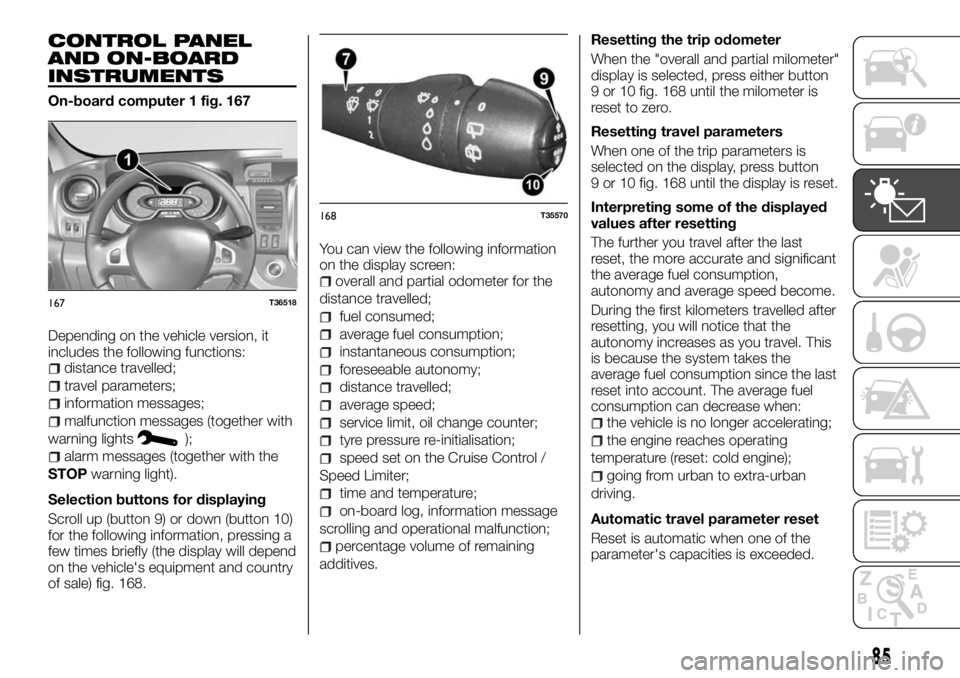
CONTROL PANEL
AND ON-BOARD
INSTRUMENTS
On-board computer 1 fig. 167
Depending on the vehicle version, it
includes the following functions:
distance travelled;
travel parameters;
information messages;
malfunction messages (together with
warning lights
);
alarm messages (together with the
STOPwarning light).
Selection buttons for displaying
Scroll up (button 9) or down (button 10)
for the following information, pressing a
few times briefly (the display will depend
on the vehicle's equipment and country
of sale) fig. 168.You can view the following information
on the display screen:
overall and partial odometer for the
distance travelled;
fuel consumed;
average fuel consumption;
instantaneous consumption;
foreseeable autonomy;
distance travelled;
average speed;
service limit, oil change counter;
tyre pressure re-initialisation;
speed set on the Cruise Control /
Speed Limiter;
time and temperature;
on-board log, information message
scrolling and operational malfunction;
percentage volume of remaining
additives.Resetting the trip odometer
When the "overall and partial milometer"
display is selected, press either button
9 or 10 fig. 168 until the milometer is
reset to zero.
Resetting travel parameters
When one of the trip parameters is
selected on the display, press button
9 or 10 fig. 168 until the display is reset.
Interpreting some of the displayed
values after resetting
The further you travel after the last
reset, the more accurate and significant
the average fuel consumption,
autonomy and average speed become.
During the first kilometers travelled after
resetting, you will notice that the
autonomy increases as you travel. This
is because the system takes the
average fuel consumption since the last
reset into account. The average fuel
consumption can decrease when:
the vehicle is no longer accelerating;
the engine reaches operating
temperature (reset: cold engine);
going from urban to extra-urban
driving.
Automatic travel parameter reset
Reset is automatic when one of the
parameter's capacities is exceeded.
167T36518
168T35570
85
Page 90 of 232
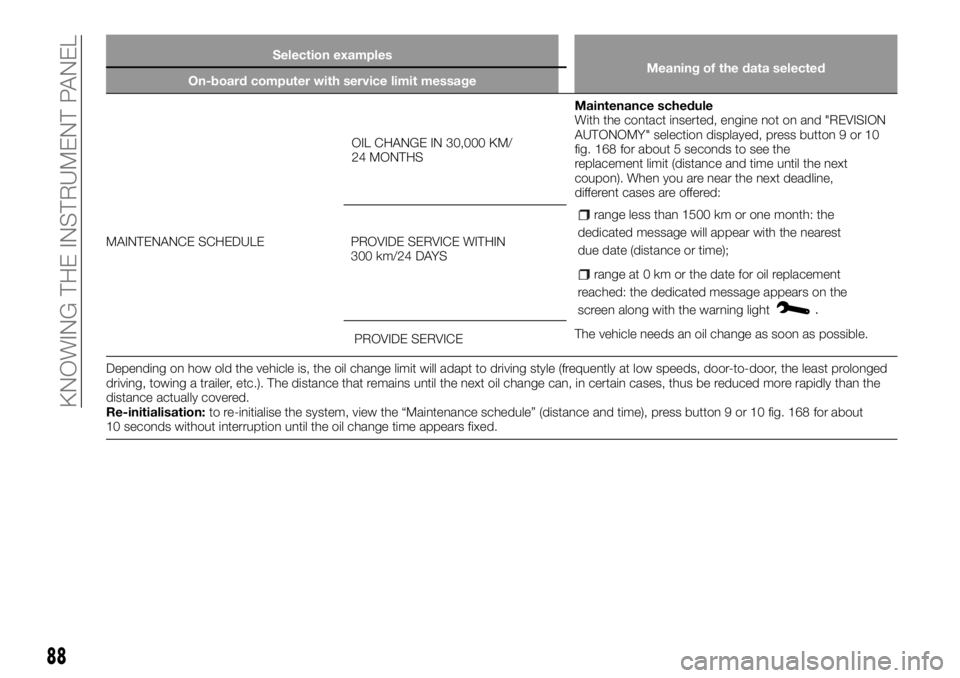
88
KNOWING THE INSTRUMENT PANEL
Selection examples
Meaning of the data selected
On-board computer with service limit message
MAINTENANCE SCHEDULEOIL CHANGE IN 30,000 KM/
24 MONTHSMaintenance schedule
With the contact inserted, engine not on and "REVISION
AUTONOMY" selection displayed, press button 9 or 10
fig. 168 for about 5 seconds to see the
replacement limit (distance and time until the next
coupon). When you are near the next deadline,
different cases are offered:
range less than 1500 km or one month: the
dedicated message will appear with the nearest
due date (distance or time);
range at 0 km or the date for oil replacement
reached: the dedicated message appears on the
screen along with the warning light
.
The vehicle needs an oil change as soon as possible. PROVIDE SERVICE WITHIN
300 km/24 DAYS
PROVIDE SERVICE
Depending on how old the vehicle is, the oil change limit will adapt to driving style (frequently at low speeds, door-to-door, the least prolonged
driving, towing a trailer, etc.). The distance that remains until the next oil change can, in certain cases, thus be reduced more rapidly than the
distance actually covered.
Re-initialisation:to re-initialise the system, view the “Maintenance schedule” (distance and time), press button 9 or 10 fig. 168 for about
10 seconds without interruption until the oil change time appears fixed.
Page 91 of 232
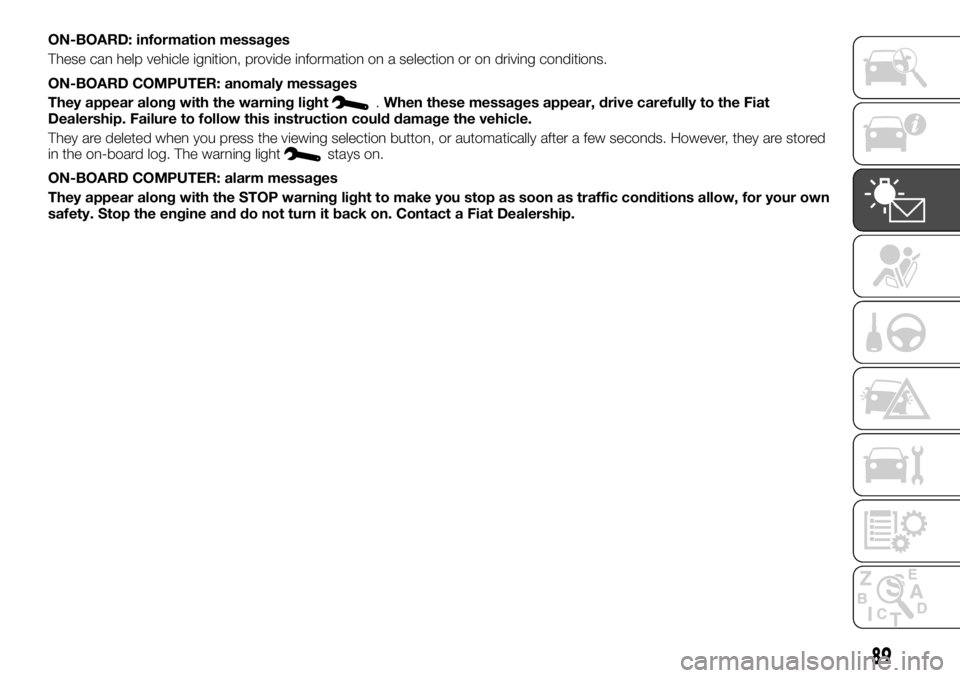
ON-BOARD: information messages
These can help vehicle ignition, provide information on a selection or on driving conditions.
ON-BOARD COMPUTER: anomaly messages
They appear along with the warning light
.When these messages appear, drive carefully to the Fiat
Dealership. Failure to follow this instruction could damage the vehicle.
They are deleted when you press the viewing selection button, or automatically after a few seconds. However, they are stored
in the on-board log. The warning light
stays on.
ON-BOARD COMPUTER: alarm messages
They appear along with the STOP warning light to make you stop as soon as traffic conditions allow, for your own
safety. Stop the engine and do not turn it back on. Contact a Fiat Dealership.
89
Page 93 of 232
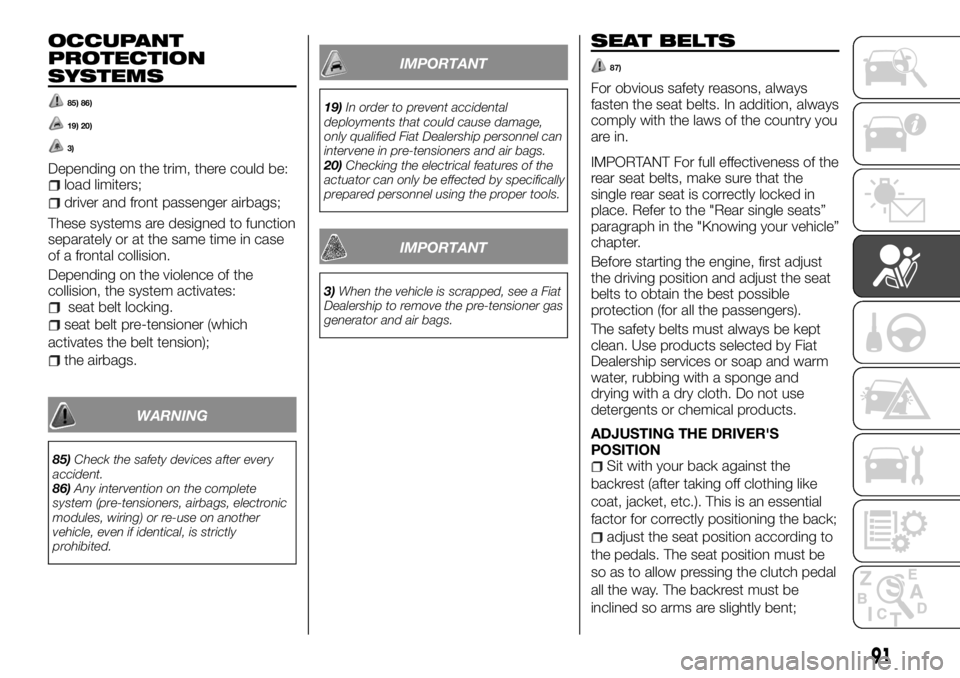
OCCUPANT
PROTECTION
SYSTEMS
85) 86)
19) 20)
3)
Depending on the trim, there could be:load limiters;
driver and front passenger airbags;
These systems are designed to function
separately or at the same time in case
of a frontal collision.
Depending on the violence of the
collision, the system activates:
seat belt locking.
seat belt pre-tensioner (which
activates the belt tension);
the airbags.
WARNING
85)Check the safety devices after every
accident.
86)Any intervention on the complete
system (pre-tensioners, airbags, electronic
modules, wiring) or re-use on another
vehicle, even if identical, is strictly
prohibited.
IMPORTANT
19)In order to prevent accidental
deployments that could cause damage,
only qualified Fiat Dealership personnel can
intervene in pre-tensioners and air bags.
20)Checking the electrical features of the
actuator can only be effected by specifically
prepared personnel using the proper tools.
IMPORTANT
3)When the vehicle is scrapped, see a Fiat
Dealership to remove the pre-tensioner gas
generator and air bags.
SEAT BELTS
87)
For obvious safety reasons, always
fasten the seat belts. In addition, always
comply with the laws of the country you
are in.
IMPORTANT For full effectiveness of the
rear seat belts, make sure that the
single rear seat is correctly locked in
place. Refer to the "Rear single seats”
paragraph in the "Knowing your vehicle”
chapter.
Before starting the engine, first adjust
the driving position and adjust the seat
belts to obtain the best possible
protection (for all the passengers).
The safety belts must always be kept
clean. Use products selected by Fiat
Dealership services or soap and warm
water, rubbing with a sponge and
drying with a dry cloth. Do not use
detergents or chemical products.
ADJUSTING THE DRIVER'S
POSITION
Sit with your back against the
backrest (after taking off clothing like
coat, jacket, etc.). This is an essential
factor for correctly positioning the back;
adjust the seat position according to
the pedals. The seat position must be
so as to allow pressing the clutch pedal
all the way. The backrest must be
inclined so arms are slightly bent;
91
Page 94 of 232
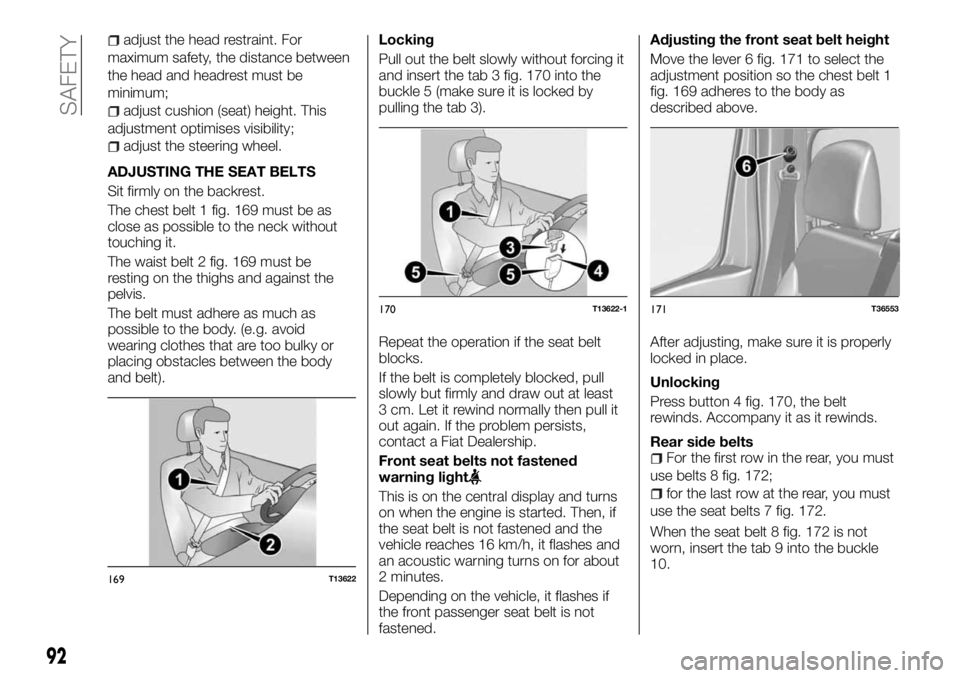
adjust the head restraint. For
maximum safety, the distance between
the head and headrest must be
minimum;
adjust cushion (seat) height. This
adjustment optimises visibility;
adjust the steering wheel.
ADJUSTING THE SEAT BELTS
Sit firmly on the backrest.
The chest belt 1 fig. 169 must be as
close as possible to the neck without
touching it.
The waist belt 2 fig. 169 must be
resting on the thighs and against the
pelvis.
The belt must adhere as much as
possible to the body. (e.g. avoid
wearing clothes that are too bulky or
placing obstacles between the body
and belt).Locking
Pull out the belt slowly without forcing it
and insert the tab 3 fig. 170 into the
buckle 5 (make sure it is locked by
pulling the tab 3).
Repeat the operation if the seat belt
blocks.
If the belt is completely blocked, pull
slowly but firmly and draw out at least
3 cm. Let it rewind normally then pull it
out again. If the problem persists,
contact a Fiat Dealership.
Front seat belts not fastened
warning light
This is on the central display and turns
on when the engine is started. Then, if
the seat belt is not fastened and the
vehicle reaches 16 km/h, it flashes and
an acoustic warning turns on for about
2 minutes.
Depending on the vehicle, it flashes if
the front passenger seat belt is not
fastened.Adjusting the front seat belt height
Move the lever 6 fig. 171 to select the
adjustment position so the chest belt 1
fig. 169 adheres to the body as
described above.
After adjusting, make sure it is properly
locked in place.
Unlocking
Press button 4 fig. 170, the belt
rewinds. Accompany it as it rewinds.
Rear side belts
For the first row in the rear, you must
use belts 8 fig. 172;
for the last row at the rear, you must
use the seat belts 7 fig. 172.
When the seat belt 8 fig. 172 is not
worn, insert the tab 9 into the buckle
10.
169T13622
170T13622-1171T36553
92
SAFETY
Page 97 of 232
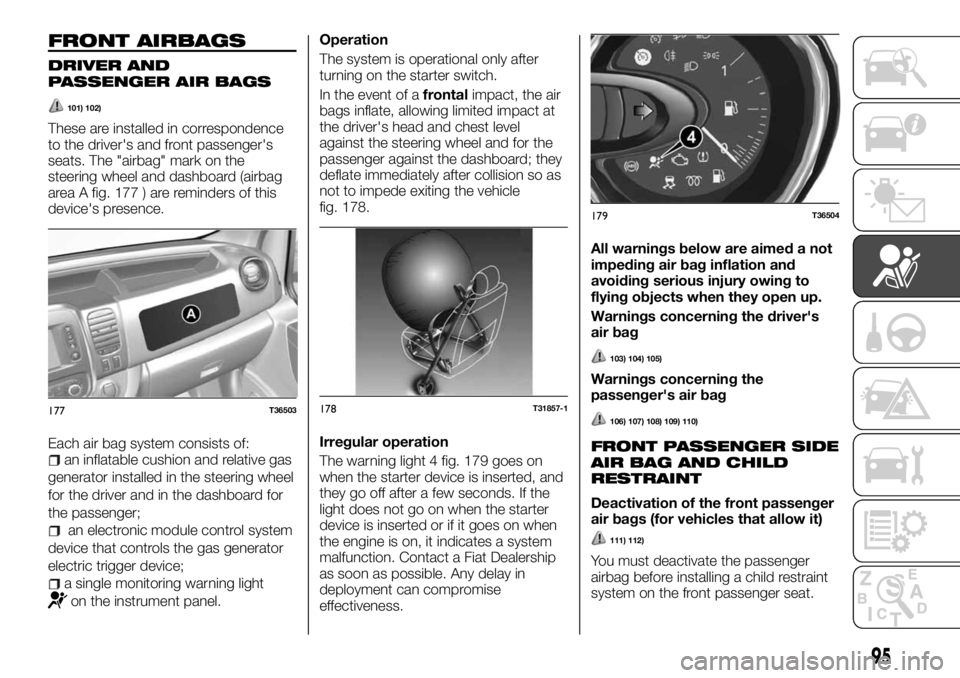
FRONT AIRBAGS
DRIVER AND
PASSENGER AIR BAGS
101) 102)
These are installed in correspondence
to the driver's and front passenger's
seats. The "airbag" mark on the
steering wheel and dashboard (airbag
area A fig. 177 ) are reminders of this
device's presence.
Each air bag system consists of:
an inflatable cushion and relative gas
generator installed in the steering wheel
for the driver and in the dashboard for
the passenger;
an electronic module control system
device that controls the gas generator
electric trigger device;
a single monitoring warning light
on the instrument panel.Operation
The system is operational only after
turning on the starter switch.
In the event of afrontalimpact, the air
bags inflate, allowing limited impact at
the driver's head and chest level
against the steering wheel and for the
passenger against the dashboard; they
deflate immediately after collision so as
not to impede exiting the vehicle
fig. 178.
Irregular operation
The warning light 4 fig. 179 goes on
when the starter device is inserted, and
they go off after a few seconds. If the
light does not go on when the starter
device is inserted or if it goes on when
the engine is on, it indicates a system
malfunction. Contact a Fiat Dealership
as soon as possible. Any delay in
deployment can compromise
effectiveness.All warnings below are aimed a not
impeding air bag inflation and
avoiding serious injury owing to
flying objects when they open up.
Warnings concerning the driver's
air bag
103) 104) 105)
Warnings concerning the
passenger's air bag
106) 107) 108) 109) 110)
FRONT PASSENGER SIDE
AIR BAG AND CHILD
RESTRAINT
Deactivation of the front passenger
air bags (for vehicles that allow it)
111) 112)
You must deactivate the passenger
airbag before installing a child restraint
system on the front passenger seat.
177T36503178T31857-1
179T36504
95
Page 98 of 232
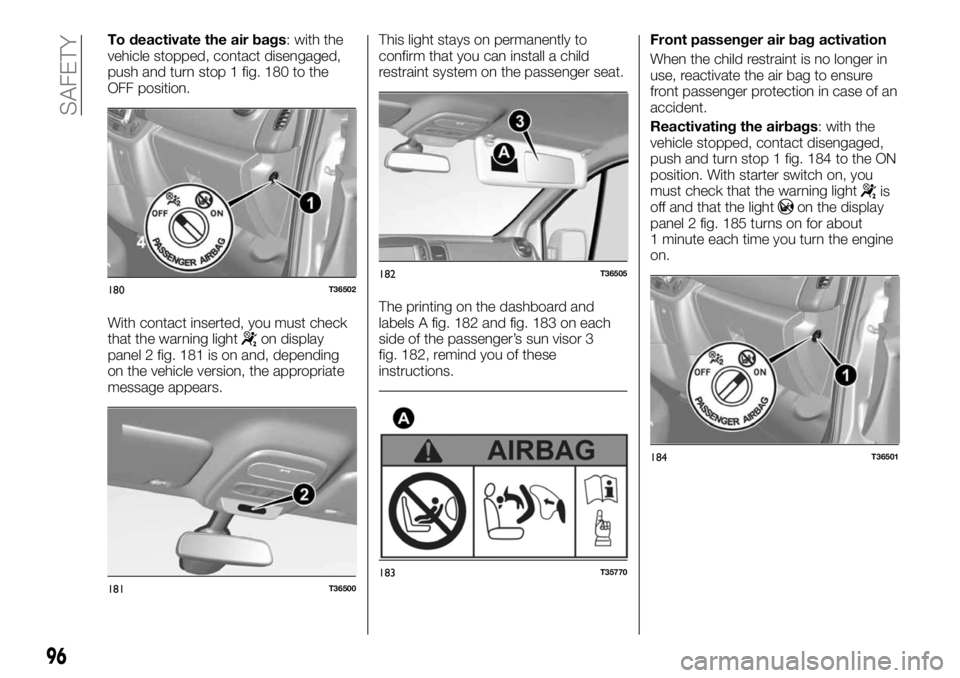
To deactivate the air bags: with the
vehicle stopped, contact disengaged,
push and turn stop 1 fig. 180 to the
OFF position.
With contact inserted, you must check
that the warning light
on display
panel 2 fig. 181 is on and, depending
on the vehicle version, the appropriate
message appears.This light stays on permanently to
confirm that you can install a child
restraint system on the passenger seat.
The printing on the dashboard and
labels A fig. 182 and fig. 183 on each
side of the passenger’s sun visor 3
fig. 182, remind you of these
instructions.Front passenger air bag activation
When the child restraint is no longer in
use, reactivate the air bag to ensure
front passenger protection in case of an
accident.
Reactivating the airbags: with the
vehicle stopped, contact disengaged,
push and turn stop 1 fig. 184 to the ON
position. With starter switch on, you
must check that the warning light
is
off and that the lighton the display
panel 2 fig. 185 turns on for about
1 minute each time you turn the engine
on.
180T36502
181T36500
182T36505
183T35770
184T36501
96
SAFETY
Page 99 of 232
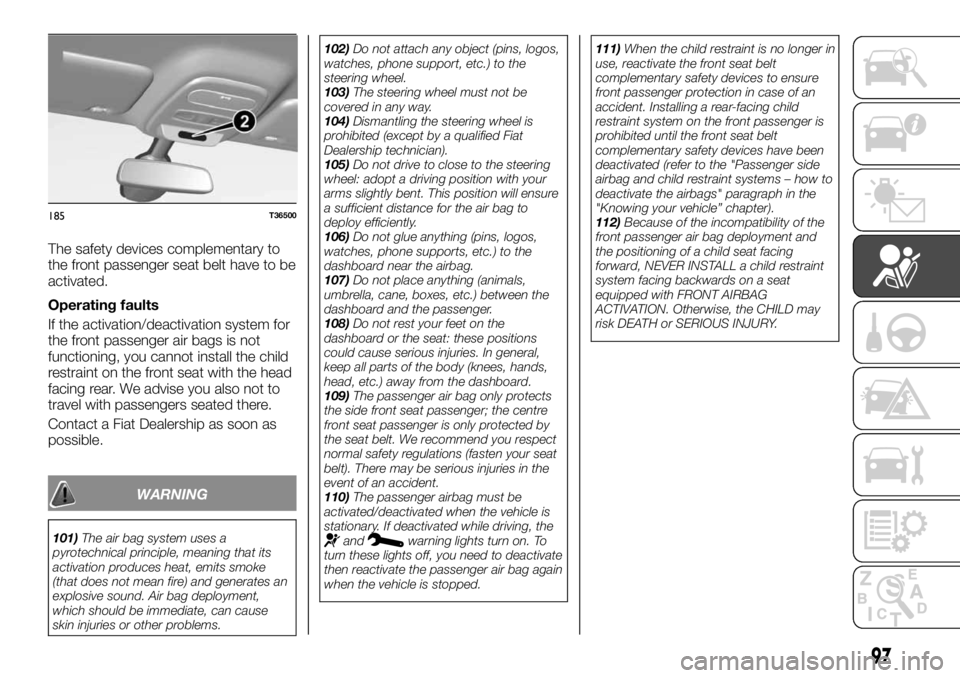
The safety devices complementary to
the front passenger seat belt have to be
activated.
Operating faults
If the activation/deactivation system for
the front passenger air bags is not
functioning, you cannot install the child
restraint on the front seat with the head
facing rear. We advise you also not to
travel with passengers seated there.
Contact a Fiat Dealership as soon as
possible.
WARNING
101)The air bag system uses a
pyrotechnical principle, meaning that its
activation produces heat, emits smoke
(that does not mean fire) and generates an
explosive sound. Air bag deployment,
which should be immediate, can cause
skin injuries or other problems.102)Do not attach any object (pins, logos,
watches, phone support, etc.) to the
steering wheel.
103)The steering wheel must not be
covered in any way.
104)Dismantling the steering wheel is
prohibited (except by a qualified Fiat
Dealership technician).
105)Do not drive to close to the steering
wheel: adopt a driving position with your
arms slightly bent. This position will ensure
a sufficient distance for the air bag to
deploy efficiently.
106)Do not glue anything (pins, logos,
watches, phone supports, etc.) to the
dashboard near the airbag.
107)Do not place anything (animals,
umbrella, cane, boxes, etc.) between the
dashboard and the passenger.
108)Do not rest your feet on the
dashboard or the seat: these positions
could cause serious injuries. In general,
keep all parts of the body (knees, hands,
head, etc.) away from the dashboard.
109)The passenger air bag only protects
the side front seat passenger; the centre
front seat passenger is only protected by
the seat belt. We recommend you respect
normal safety regulations (fasten your seat
belt). There may be serious injuries in the
event of an accident.
110)The passenger airbag must be
activated/deactivated when the vehicle is
stationary. If deactivated while driving, theandwarning lights turn on. To
turn these lights off, you need to deactivate
then reactivate the passenger air bag again
when the vehicle is stopped.111)When the child restraint is no longer in
use, reactivate the front seat belt
complementary safety devices to ensure
front passenger protection in case of an
accident. Installing a rear-facing child
restraint system on the front passenger is
prohibited until the front seat belt
complementary safety devices have been
deactivated (refer to the "Passenger side
airbag and child restraint systems – how to
deactivate the airbags" paragraph in the
"Knowing your vehicle” chapter).
112)Because of the incompatibility of the
front passenger air bag deployment and
the positioning of a child seat facing
forward, NEVER INSTALL a child restraint
system facing backwards on a seat
equipped with FRONT AIRBAG
ACTIVATION. Otherwise, the CHILD may
risk DEATH or SERIOUS INJURY.
185T36500
97
Page 126 of 232
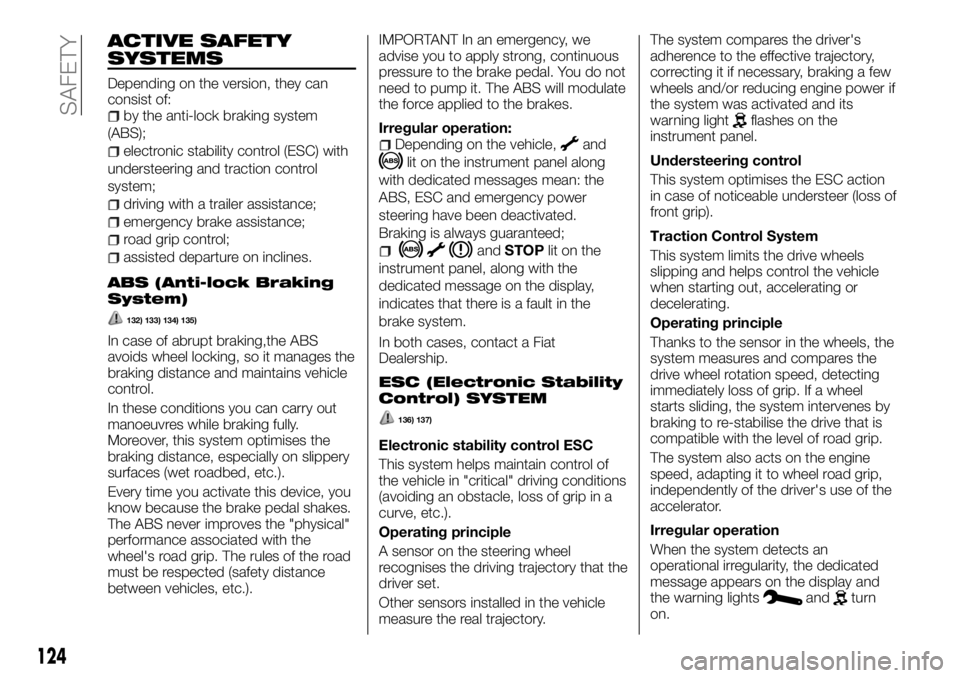
ACTIVE SAFETY
SYSTEMS
Depending on the version, they can
consist of:
by the anti-lock braking system
(ABS);
electronic stability control (ESC) with
understeering and traction control
system;
driving with a trailer assistance;
emergency brake assistance;
road grip control;
assisted departure on inclines.
ABS (Anti-lock Braking
System)
132) 133) 134) 135)
In case of abrupt braking,the ABS
avoids wheel locking, so it manages the
braking distance and maintains vehicle
control.
In these conditions you can carry out
manoeuvres while braking fully.
Moreover, this system optimises the
braking distance, especially on slippery
surfaces (wet roadbed, etc.).
Every time you activate this device, you
know because the brake pedal shakes.
The ABS never improves the "physical"
performance associated with the
wheel's road grip. The rules of the road
must be respected (safety distance
between vehicles, etc.).IMPORTANT In an emergency, we
advise you to apply strong, continuous
pressure to the brake pedal. You do not
need to pump it. The ABS will modulate
the force applied to the brakes.
Irregular operation:
Depending on the vehicle,and
lit on the instrument panel along
with dedicated messages mean: the
ABS, ESC and emergency power
steering have been deactivated.
Braking is always guaranteed;
andSTOPlit on the
instrument panel, along with the
dedicated message on the display,
indicates that there is a fault in the
brake system.
In both cases, contact a Fiat
Dealership.
ESC (Electronic Stability
Control) SYSTEM
136) 137)
Electronic stability control ESC
This system helps maintain control of
the vehicle in "critical" driving conditions
(avoiding an obstacle, loss of grip in a
curve, etc.).
Operating principle
A sensor on the steering wheel
recognises the driving trajectory that the
driver set.
Other sensors installed in the vehicle
measure the real trajectory.The system compares the driver's
adherence to the effective trajectory,
correcting it if necessary, braking a few
wheels and/or reducing engine power if
the system was activated and its
warning light
flashes on the
instrument panel.
Understeering control
This system optimises the ESC action
in case of noticeable understeer (loss of
front grip).
Traction Control System
This system limits the drive wheels
slipping and helps control the vehicle
when starting out, accelerating or
decelerating.
Operating principle
Thanks to the sensor in the wheels, the
system measures and compares the
drive wheel rotation speed, detecting
immediately loss of grip. If a wheel
starts sliding, the system intervenes by
braking to re-stabilise the drive that is
compatible with the level of road grip.
The system also acts on the engine
speed, adapting it to wheel road grip,
independently of the driver's use of the
accelerator.
Irregular operation
When the system detects an
operational irregularity, the dedicated
message appears on the display and
the warning lights
andturn
on.
124
SAFETY